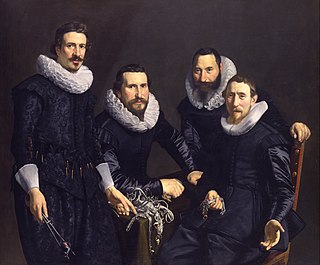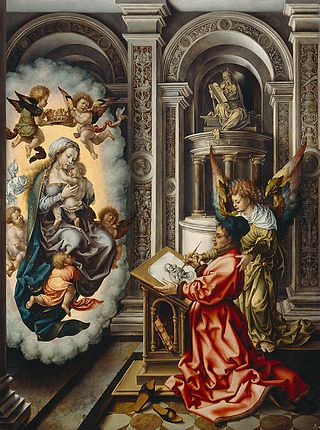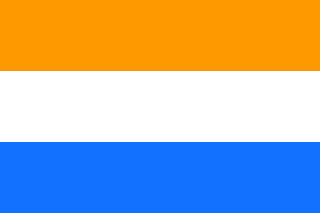
Utrecht is the fourth-largest city of the Netherlands, as well as the capital and the most populous city of the province of Utrecht. The municipality of Utrecht is located in the eastern part of the Randstad conurbation, in the very centre of mainland Netherlands, and includes Haarzuilens, Vleuten en De Meern. It has a population of 361,699 as of December 2021.

The Dom Tower of Utrecht is the tallest church tower in the Netherlands, at 112.32 metres (368,5 feet) in height. It is considered the symbol of Utrecht. The tower was part of St. Martin's Cathedral, also known as the Dom Church, and was built between 1321 and 1382, to a design by John of Hainaut. The cathedral was never fully completed due to lack of money. Since the unfinished nave collapsed in 1674, the Dom tower has been a freestanding tower. The tower stands at the spot where the city of Utrecht originated almost 2,000 years ago.

St. Martin's Cathedral, Utrecht, or Dom Church, is a Gothic church dedicated to Saint Martin of Tours, which was the cathedral of the Diocese of Utrecht during the Middle Ages. It is the country's only pre-Reformation cathedral, but has been a Protestant church since 1580.

Haarlem is one of the cities in the Netherlands that has a number of hofjes. Some of them are still in use with boards of regents. Many of these are members of the Stichting Haarlemse Hofjes. The word 'hofje' just means small garden, because the hofjes are generally small houses grouped around a community kitchen garden with a water pump. Often they were attached to a larger field for bleaching linen or growing orchards, but today those fields have been long used for city expansion and only the central gardens can still be seen.

The ruins of the Huis ter Kleef castle are located in the city gardens of Haarlem.

Thomas de Keyser was a Dutch portrait painter and a dealer in Belgium bluestone and stone mason. He was the most in-demand portrait painter in the Netherlands until the 1630s, when Rembrandt eclipsed him in popularity. Rembrandt was influenced by his work, and many of de Keyser's paintings were later falsely attributed to Rembrandt.

Kolven is a game originating from the Netherlands. The game is played by four people who hit the ball over a certain distance. The first people to reach their opponents' starting point win. Games can last multiple days.
The Zoudenbalch family was one of the most prominent families of Utrecht throughout the Middle Ages to the age of the Dutch Revolt. They occupied all posts of importance in the city government, possessed various lordships in the vicinity and played a leading role in the history of the Sticht. The Zoudenbalchs were also Lords of the island of Urk in the Zuiderzee for over a century (1476–1614), and as such played a key role in the life of that community during troubled times in the 16th century.

The Guild of Saint Luke was the most common name for a city guild for painters and other artists in early modern Europe, especially in the Low Countries. They were named in honor of the Evangelist Luke, the patron saint of artists, who was identified by John of Damascus as having painted the Virgin's portrait.

Guy van Avennes was Bishop of Utrecht from 1301 to 1317.

The Vrouwe- en Antonie Gasthuis is a hofje on the Klein Heiligland 64a in Haarlem, Netherlands. It is open on weekdays from 10-17.00.

Museum van de Geest, was created in 2020 when museum Het Dolhuys, the national museum for psychiatry in Haarlem, Netherlands, which was founded in 2005 in the newly renovated former old age home known as Schoterburcht, located just across the Schotersingel from the Staten Bolwerk park, merged with the Outsider Art Museum from Amsterdam.

The Janskerk or St. John's Church is a former church in the Dutch city of Haarlem. Today it houses the North Holland Archives.

The Utrecht Guild of Saint Luke refers to two artist collectives in Utrecht (city); the old Catholic Zadelaarsgilde dating from the Middle Ages, as well as the newer Sint Lucas Gilde established in 1611. The first guild was for a number of trades that were connected to the art industry, though the smiths had their own guild called the "St. Eloyen" guild. The second collective was founded for visual artists after the Protestant Reformation. The Zadelaarsgilde fell under the patron saint Luke the Evangelist and the St. Eloyen guild fell under Saint Eligius.

Joost Cornelisz Droochsloot or Droogsloot, was a Dutch painter of village scenes, landscapes, genre pictures, moral allegories and biblical stories.

The Dutch Republic existed from 1579 to 1795 and was a confederation of seven provinces, which had their own governments and were very independent, and a number of so-called Generality Lands. These latter were governed directly by the States-General, the federal government. The States-General were seated in The Hague and consisted of representatives of each of the seven provinces.

The St. Elisabeth Gasthuis (EG) is a former hospital complex of buildings founded in 1581 in Haarlem on the Gasthuisvest. The last location of the hospital on the Boerhaavelaan retains its hospital function and is part of the Spaarne Gasthuis (SG) today, formerly known as Kennemer Gasthuis (KG). The hospital complex on the Gasthuisvest was built for the "Minnebroers" monastery and was reclaimed after the Protestant reformation in 1581 and given by the city council to the hospital. As a hospital during four centuries, the complex underwent many major renovations. The main facade dates from 1871.

The Buurkerk is a former church building in Utrecht (city), Netherlands on the Buurkerkhof. The building is the location of the Museum Speelklok, and the entrance is on the Steenweg. It is one of the medieval parish churches of Utrecht, along with the Jacobikerk, the Nicolaïkerk and the Geertekerk.
The following is a timeline of the history of the municipality of Utrecht, Netherlands.

Elisabeth Gasthuis Poort is the address of a doorway in Haarlem. The neo-classical stone doorway is dated 1767 in roman numerals, and the gable stone set into it from 1612 was repainted in 2017. The entire doorway is part of the Elisabeth Gasthuis complex and has itself been declared one of the national monuments of The Netherlands.


















